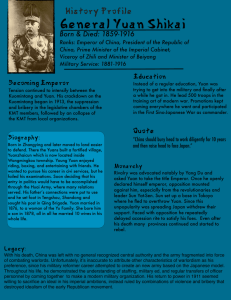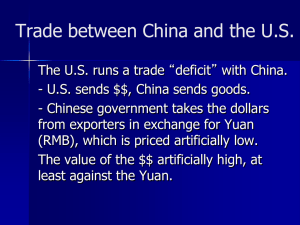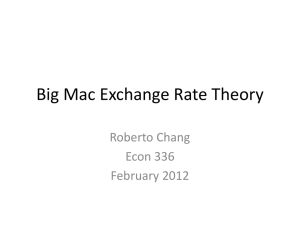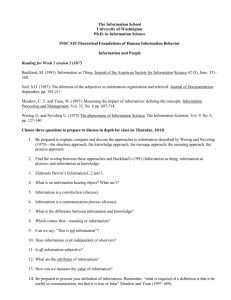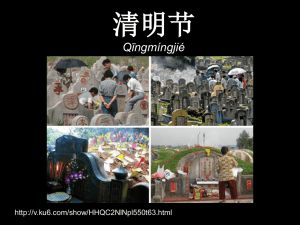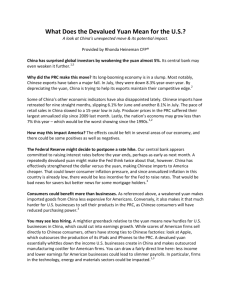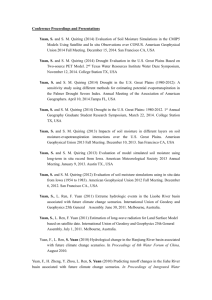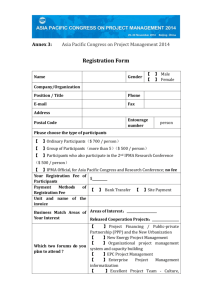Junying Yuan - American Society for Cell Biology
advertisement
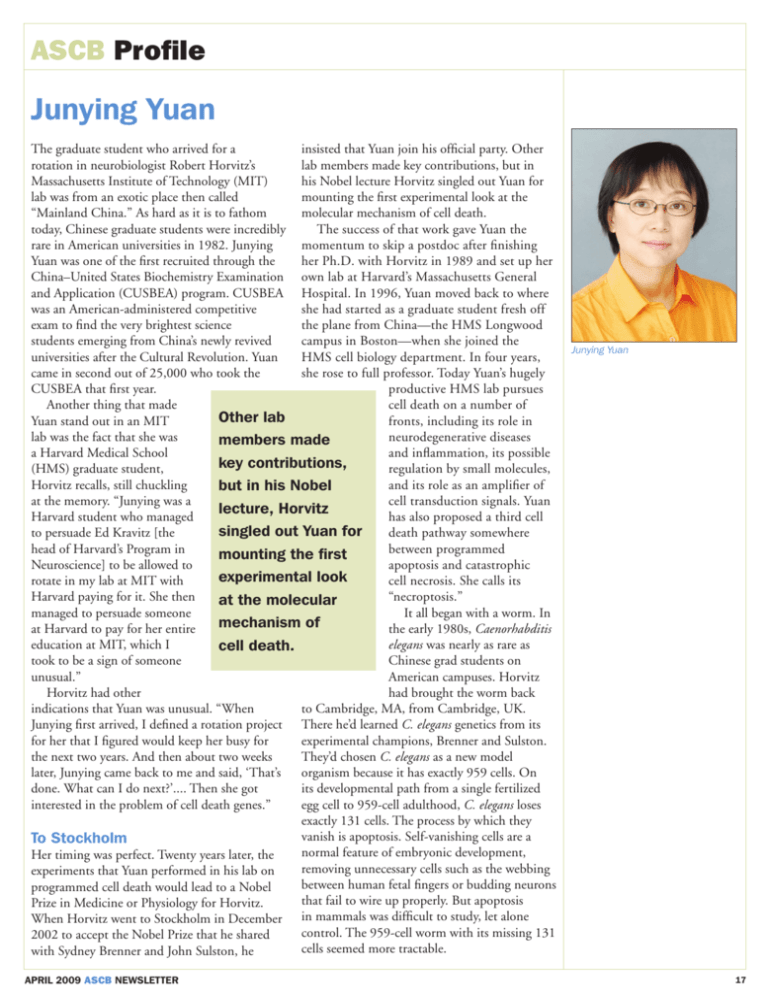
ASCB Profile Junying Yuan The graduate student who arrived for a insisted that Yuan join his official party. Other rotation in neurobiologist Robert Horvitz’s lab members made key contributions, but in Massachusetts Institute of Technology (MIT) his Nobel lecture Horvitz singled out Yuan for lab was from an exotic place then called mounting the first experimental look at the “Mainland China.” As hard as it is to fathom molecular mechanism of cell death. today, Chinese graduate students were incredibly The success of that work gave Yuan the rare in American universities in 1982. Junying momentum to skip a postdoc after finishing Yuan was one of the first recruited through the her Ph.D. with Horvitz in 1989 and set up her China–United States Biochemistry Examination own lab at Harvard’s Massachusetts General and Application (CUSBEA) program. CUSBEA Hospital. In 1996, Yuan moved back to where was an American-administered competitive she had started as a graduate student fresh off exam to find the very brightest science the plane from China—the HMS Longwood students emerging from China’s newly revived campus in Boston—when she joined the universities after the Cultural Revolution. Yuan HMS cell biology department. In four years, came in second out of 25,000 who took the she rose to full professor. Today Yuan’s hugely CUSBEA that first year. productive HMS lab pursues Another thing that made cell death on a number of Other lab Yuan stand out in an MIT fronts, including its role in lab was the fact that she was neurodegenerative diseases members made a Harvard Medical School and inflammation, its possible key contributions, (HMS) graduate student, regulation by small molecules, Horvitz recalls, still chuckling and its role as an amplifier of but in his Nobel at the memory. “Junying was a cell transduction signals. Yuan lecture, Horvitz Harvard student who managed has also proposed a third cell singled out Yuan for to persuade Ed Kravitz [the death pathway somewhere head of Harvard’s Program in between programmed mounting the first Neuroscience] to be allowed to apoptosis and catastrophic experimental look rotate in my lab at MIT with cell necrosis. She calls its Harvard paying for it. She then “necroptosis.” at the molecular managed to persuade someone It all began with a worm. In mechanism of at Harvard to pay for her entire the early 1980s, Caenorhabditis education at MIT, which I elegans was nearly as rare as cell death. took to be a sign of someone Chinese grad students on unusual.” American campuses. Horvitz Horvitz had other had brought the worm back indications that Yuan was unusual. “When to Cambridge, MA, from Cambridge, UK. Junying first arrived, I defined a rotation project There he’d learned C. elegans genetics from its for her that I figured would keep her busy for experimental champions, Brenner and Sulston. the next two years. And then about two weeks They’d chosen C. elegans as a new model later, Junying came back to me and said, ‘That’s organism because it has exactly 959 cells. On done. What can I do next?’.... Then she got its developmental path from a single fertilized interested in the problem of cell death genes.” egg cell to 959-cell adulthood, C. elegans loses exactly 131 cells. The process by which they vanish is apoptosis. Self-vanishing cells are a To Stockholm normal feature of embryonic development, Her timing was perfect. Twenty years later, the removing unnecessary cells such as the webbing experiments that Yuan performed in his lab on between human fetal fingers or budding neurons programmed cell death would lead to a Nobel that fail to wire up properly. But apoptosis Prize in Medicine or Physiology for Horvitz. When Horvitz went to Stockholm in December in mammals was difficult to study, let alone control. The 959-cell worm with its missing 131 2002 to accept the Nobel Prize that he shared cells seemed more tractable. with Sydney Brenner and John Sulston, he APRIL 2009 ASCB NEWSLETTER Junying Yuan 17 Null for Cell Death first job as an inept factory worker in China, she would be retired now. But the story is no joke. Just before Yuan’s arrival, the Horvitz lab found Yuan comes from a Shanghai family of scientists. its first C. elegans mutant that was null for Her grandfather was an organic chemist. Her cell death. These mutants would develop into father was an anatomist, her mother a botanist adult worms with the normal complement of and expert on traditional Chinese medicine. cells plus 131 extra ones that should have been That made the family “intellectuals,” and in stricken off by apoptosis. (Lab members called the turmoil of the Cultural the mutant’s extra cells “the Revolution such a background undead.”) The mutants gave made Junying Yuan ineligible the researchers two leading to attend a university. After a gene candidates for cell suicide Yuan jokes that if patchy high school education, directors, ced-3 and ced-4. she had stayed in she was assigned to a factory Horvitz quickly switched his that made heavy machinery. fast-working grad student to her first job as an “I hated it,” Yuan recalls. ced genes. inept factory worker “Also I was no good at it, but According to Horvitz, fortunately the boss mostly let in China, she would “Junying was the one who me sit there and watch.” showed that ced-3 and cedbe retired now. But A high school teacher who 4 are suicide genes. She did the story is no joke. had seen Yuan’s potential the experiments that showed rescued her. Catching wind of these genes acted within the a new competitive university cells that are going to die. They entrance exam open to all, do not send out signals, as the teacher insisted that Yuan many people thought, to other cells to commit start cramming. Only there were no modern suicide.” textbooks, Yuan recalls. Those that hadn’t been It was Yuan who also helped make the burned by the Red Guards were locked away in experimental connection between a cell death schools. Her teacher broke into the high school gene in worms and a cell death mechanism in library at night to steal the books Yuan needed. humans, says Horvitz. Working with fellow After four frantic months of self-tutoring, Yuan grad student Shai Shasham (now at Rockefeller took the first open college entrance exam for University), Yuan discovered that ced-3 in C. a place at the reformed Fudan University. She elegans encoded a protein that turned out to placed first in Shanghai out of the more than be similar to a human protease, interleukin100,000 high school graduates who took the 1-β converting enzyme (ICE). The ICEexam. derived protein in humans and the CED-3 protein in worms were the first in a family of Arguing with Deans cell death proteases now known as the caspases. Four years later, her CUSBEA exam scores “That was the first caspase, and to this day caught the attention of Harvard biochemist the best demonstration of the mechanistic Manfred Karnovsky. It was Karnovsky who basis of apoptosis,” Horvitz declares. “Junying discovered that first caspase while she was still in brought Yuan’s eye-popping results to HMS neurobiologist Ed Kravitz. Sight unseen, my lab. She brought it into mammals, literally Kravitz offered Yuan a place. Kravitz was and figuratively. That was one-third of the not disappointed when he met the quietly Nobel right there,” he maintains. determined young woman from Shanghai that fall. Kravitz remembers, “Clearly, Junying was The First Caspase very smart but she was also thoughtful. You Horvitz continues, “Everything she did [in would not pick her out as a hyperaggressive my lab] was golden. That’s continued through person or as a super-shy one. She had her her whole career, and she’s just done a whole opinions and she wasn’t shy in expressing them.” litany of things. She’s had a whole series of There was the matter of lab placements, breakthrough studies in cell death, and then she Kravitz recalls. Harvard’s new cross-campus turned to human disease and has done some neuroscience program sent her on three-month work on Huntington’s and Alzheimer’s that is rotations through labs in the medical school and just spectacular. She’s the ultimate innovative on the main campus in Cambridge. “Junying scientist, the real pioneer, because she keeps just couldn’t find a lab to work in. She’d do a doing things that are new.” rotation and then come back and say, ‘No, that’s Junying Yuan’s career nearly didn’t happen not the one.’” at all. Yuan jokes that if she had stayed in her 18 ASCB NEWSLETTER APRIL 2009 Kravitz helped tip Yuan toward the question of cell death. He taught a survey course on neurodegenerative diseases and liked to start each week’s discussion of a disease with a guest presentation from a leading Harvard clinician. Typically, the clinician would bring along a patient. Yuan remembers being impressed by the dignity of the patients but unimpressed by the eminent specialists. “They [the experts] really didn’t know anything about these diseases,” she recalls with indignation. “All they could do was tell us how they differentiated in diagnosis between Alzheimer’s or Huntington’s. But they had no treatments, and I thought that if I am a patient, it doesn’t make much difference to me which way I am going to die.” Yet Yuan believed that there was a link between all these neurodegenerative diseases: They all involved selective die-off of neurons. Yuan couldn’t find anyone who addressed her new interest until she heard Horvitz, then a junior faculty member from MIT, talk about his work with an unusual model organism on something called programmed cell suicide. So Yuan found her lab—with Horvitz at MIT—and Kravitz found himself arguing with various Harvard deans. “Obviously, it worked out,” says Kravitz with pride. The rest is Nobel history, and today cell death is the central issue in a vast amount of research on subjects from cancer to spinal cord regeneration. Have You Eaten? Yuan’s husband, Qiang Yu, a biochemistry professor at Boston University, is back in Shanghai running the pharmaceutical company that he started there four years ago. A member of the ASCB since 1999, Yuan has become increasingly concerned with women’s issues in science. Last year she joined the Society’s Women in Cell Biology Committee. “I have been very lucky in that I have had a lot of good mentors,” Yuan explains. “But I’ve always thought that I should give back. Perhaps it’s easier for me to connect to young women.” Like many high-performers, Yuan is a marvel of efficiency and fierce concentration. She says she never goes to an airport, a doctor’s appointment, or a child’s sports practice without her faithful bag of journals and manuscript drafts. She is a fervent user of the Blackberry, as her lab members soon discover. She replies almost instantly to their emails, even when she’s in Shanghai on a visit home. “I feel nervous if I don’t have my Blackberry,” Yuan confesses, adding that she totally understood Barack Obama’s reluctance to part with his after the election. “I feel very glad to share the same passion for the Blackberry as President Obama,” says the professor of cell biology at HMS. It is a statement that shows how far science, the world, and the Blackberry have come since Junying Yuan came to America. n —John Fleischman “Junying just couldn’t find a lab to work in. She’d do a rotation and then come back and say, ‘No, that’s not the one’,” Kravitz recalls. Pushed into remembering, Yuan looks back on her first days in America and her arrival on the deserted Longwood campus in the last days of summer. She found herself virtually alone in her HMS dormitory with nothing to eat but Greek salad from the local delicatessen. Yuan was appalled. In the Chinese culinary tradition, raw salad is not food. “At the end of three days, I was really starving,” she recalls. “My mother had given me a package for a friend of a friend in Boston. I had the phone number, so I went to a phone booth and called. In Chinese, the normal greeting is ‘Oh, have you eaten?’ and when this man answered and said, ‘Have you eaten?,’ tears dropped down my face.” The couple rescued Yuan from starvation. “This family became my adopted family and every weekend they took me into their house to feed me,” Yuan recalls. “Now they are retired, I feed them at my house.” That house is in nearby Newton where her daughter, Julia Yu, 16, is in high school. Her son, Albert Yu, 19, is taking a gap year after high school. Although his interests are in science, his parents await bulletins on his precise intentions. APRIL 2009 ASCB NEWSLETTER 19
